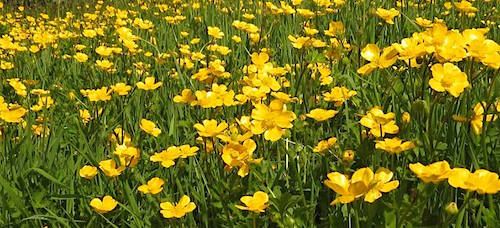
Not much beats a meadow full of golden buttercups.
Photo: Jörg Hempel, CC BY-SA 2.0 DE, via Wikimedia Commons
Scientific name: Ranunculus repens
Other common names: Goldweed and Soldier Buttons (both now obsolete), Crowpeckle (Northamptonshire)
What to look for:
• Family: Ranunculus (Buttercup family)
• Flowers: Golden yellow flowers, about two cm in diameter, with five petals.
• Leaves and stem: The flower stalk is grooved (in common with Bulbous but not Meadow Buttercup), and the sepals are spreading (in common with Meadow but not Bulbous Buttercup – the latter has reflexed sepals). Creeping runners, rooting from nodes. Hairy leaves with three lobes.
• Height: Up to 60 cm tall.
• Where: Very common in many habitats, especially damper areas.
• When: Flowers May to August.
• Habit: Upright, spreading.
A buttercup is a buttercup, right? Well, no, actually. There are, in fact, several species of what most of us think of as just buttercups. The three that are most commonly associated with our childhood meadow games (see ‘Did you know…?’ below) are Meadow Buttercup (Ranunculus acris), Bulbous Buttercup (R. bulbosus) and Creeping Buttercup (R. repens).
Creeping Buttercup is found in most habitats, including woodlands, field edges and wasteland, and has a preference for damper areas. You might find it in your garden, too, though many gardeners dislike it as it spreads quickly through a lawn. It does that using runners. New roots and plants grow from nodes along the runners, which ‘creep’ horizontally across the ground – hence this buttercup’s common name.
There is a link in the references below to an excellent BSBI key, which helps distinguish Creeping, Meadow and Bulbous Buttercup. Simple rules of thumb would be a buttercup that has runners, a grooved flower stalk and spreading sepals is very probably going to be Creeping Buttercup.

Did you know…?
…In childhood, many of us will have played the game of holding a buttercup below a friend’s chin, to see if it casts a golden reflection. If it does, then that person likes butter.
…Creeping Buttercup has been introduced as an ornamental plant to many parts of the world. It is generally considered an invasive weed outside of its natural distribution in Europe, Asia and North-west Africa.
More information and references:
Mabey, R., 1997. Flora Britannica. Chatto & Windus, London.
Rich, T.C.G. and Jermy, A.C., 1998. Plant Crib: Ranunculus Subgenus Ranunculus. BSBI (accessed online)
Rose, F. and O’Reilly, C., 2006. The Wild Flower Key, 2nd edition. Frederick Warne, London.
Stace, C., 2010. New Flora of the British Isles, 3rd edition. Cambridge University Press, Cambridge.

Published: June 2016
Author: Amanda Scott
Photos: Upper – Jörg Hempel, CC BY-SA 2.0 DE, via Wikimedia Commons; lower – Steve Townsend
